
Top 9 Biryani recipes for Biryani lovers!
Biryani is not just a dish; it’s an experience, a tradition that transcends geographical and cultural boundaries, with a rich history that adds to its allure. Originating from the Indian subcontinent, biryani is a mixed rice dish that’s known for its tantalizing aromas, vibrant colors, and exquisite flavors. It’s made with Indian spices, rice, and usually some type of meat (chicken, beef, goat, pork, lamb, prawn, or fish), but there are also numerous vegetarian variations. The key components of biryani – rice, spices, and marinated meat or vegetables – are layered meticulously and cooked over low heat to perfection. The history of biryani is as flavorful as the dish itself, with several theories about its origins.
Origin and History
The word “biryani” is derived from the Persian word “birian,” which means “fried before cooking,” and indeed, its origins trace back to ancient Persia. It is widely believed that biryani was brought to the Indian subcontinent by the Mughals, making its way into the Indian culinary tradition in the late 16th century. Another theory suggests that the dish was known in India even before the Mughals’ arrival, possibly as a rustic version that was refined by the Mughals into the delicacy it is today.
The traditional method of cooking biryani involved a technique called “dum,” where the ingredients are slowly cooked in a sealed, heavy bottomed vessel, allowing the meat to tenderize and the flavors of the spices, meat, and rice to meld together beautifully.
Types of Biryani
1. Hyderabadi Biryani
2. Lucknowi (Awadhi) Biryani
3. Kolkata (Calcutta) Biryani
4. Malabar Biryani
5. Sindhi Biryani
6. Vegetarian Biryani
7. Prawn Biyani
8. Fish Biryani
9. Lamb Biryani
Over the centuries, various regional variations of biryani have evolved across the Indian subcontinent, each with its unique twist, influenced by local flavors and traditions. Here are some of the most popular types:
1. Hyderabadi Biryani:
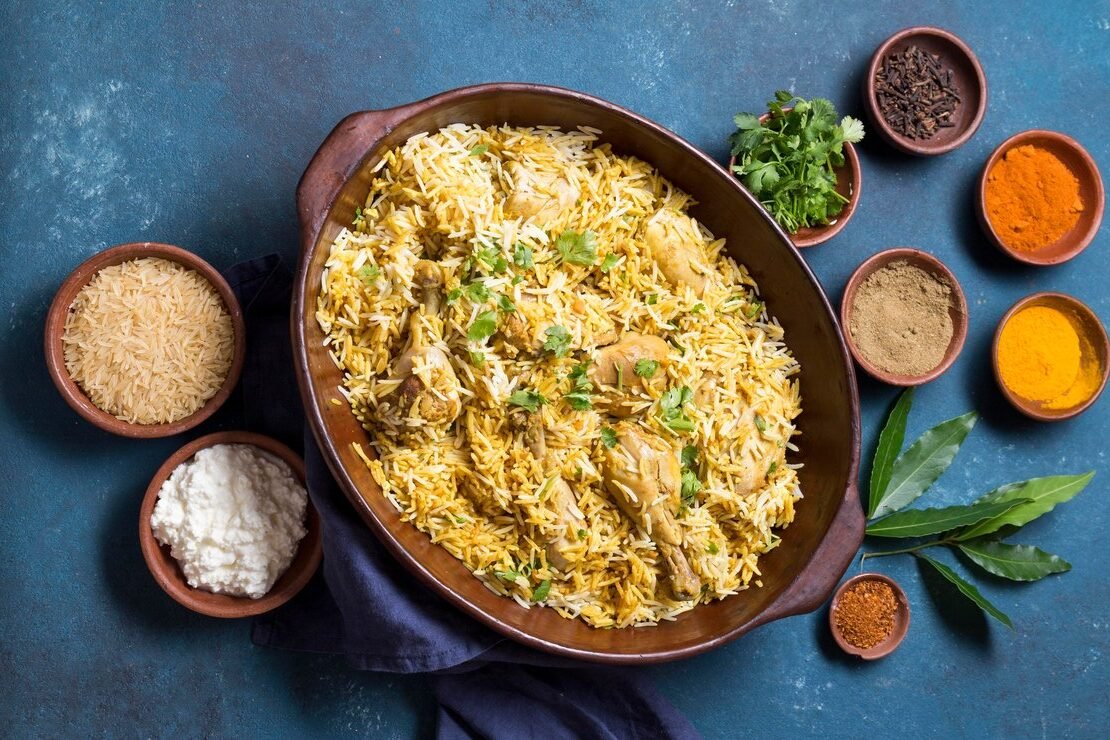
From the city of Hyderabad in South India, known for its rich and aromatic flavor, cooked in the “dum” style. It comes in two types the Kacchi (raw) biryani and Pakki (cooked) biryani.
Hyderabadi Biryani is a gem from the Indian culinary tradition, cherished for its incredible aroma, vibrant flavors, and the perfect blend of rice, meat, and spices. It’s a celebration dish often cooked with chicken or mutton, but today, I’ll guide you through the steps to make a classic Hyderabadi Chicken Biryani in the traditional ‘dum’ method, where it’s cooked with its own steam.
| Ingredients: | ||
|---|---|---|
| For the Chicken Marinade: | For the Rice: | For Biryani: |
| 1 kg chicken, cut into pieces | 2 1/2 cups basmati rice | 1/2 cup oil or ghee |
| 1 cup yogurt (thick) | 8 cups water | 1 large onion, thinly sliced (for frying) |
| 1 tablespoon ginger-garlic paste | 15 cloves | Saffron strands, a pinch (soaked in 1/4 cup warm milk) |
| 2 teaspoons chili powder (adjust to taste) | 15 cardamom pods | 1/2 teaspoon kewra water or rose water (optional) |
| 1/2 teaspoon turmeric powder | 1 bay leaf | Dough (for sealing the pot, optional) |
| 1 teaspoon garam masala | 1 cinnamon stick | |
| 1 tablespoon lemon juice | Salt to taste | |
| 1/2 cup fried onions | ||
| 1/2 cup chopped mint leaves | ||
| 1/2 cup chopped cilantro (coriander leaves) | ||
| 8 green chilies, slit | ||
| Salt to taste |
Instructions:
Marinate the Chicken:
- Mix yogurt, ginger-garlic paste, chili powder, turmeric, garam masala, lemon juice, half of the fried onions, mint, cilantro, green chilies, and salt in a bowl.
- Add the chicken pieces to this marinade and mix well. Ensure each piece is coated. Marinate for at least 3 hours, preferably overnight in the refrigerator.
Prepare the Rice:
- Rinse the basmati rice until the water runs clear to remove excess starch. Soak in water for about 30 minutes, then drain.
- Bring 8 cups of water to a boil in a large pot. Add cloves, cardamom, bay leaf, cinnamon, and salt.
- Add the soaked and drained rice to the boiling water. Cook until the rice is about 70% done (partially cooked but still firm). Drain and set aside.
Layering the Biryani:
- In a thick bottomed pot (preferably a heavy-duty, deep pot), heat oil or ghee. Fry the remaining sliced onions until golden brown. Remove and set aside.
- In the same pot, add the marinated chicken. Spread it evenly across the bottom. Cook on high heat for 2 minutes.
- Lower the heat. Over the chicken, layer the partially cooked rice evenly.
- Sprinkle the saffron infused milk, kewra water, fried onions, some chopped mint, and cilantro over the rice.
- Seal the pot with a tight fitting lid. Optionally, seal the edges with dough to ensure no steam escapes (this is the ‘dum’ process).
Cooking:
- Cook on high heat for about 5 minutes, and then reduce to the lowest possible heat. Allow to cook for 35 to 40 minutes. The steam trapped inside helps in cooking the chicken and infusing the rice with flavors.
- Let the biryani sit for about 10 minutes after turning off the heat before opening the lid.
Serving:
Carefully mix the biryani before serving to ensure the layers of rice and chicken are combined. Serve hot with raita (yogurt sauce), sliced cucumbers, and lemon wedges on the side.
Enjoy the aromatic and flavorful journey of this Hyderabadi Chicken Biryani, a dish that beautifully encapsulates the essence of Hyderabadi cuisine.
2. Lucknowi (Awadhi) Biryani:
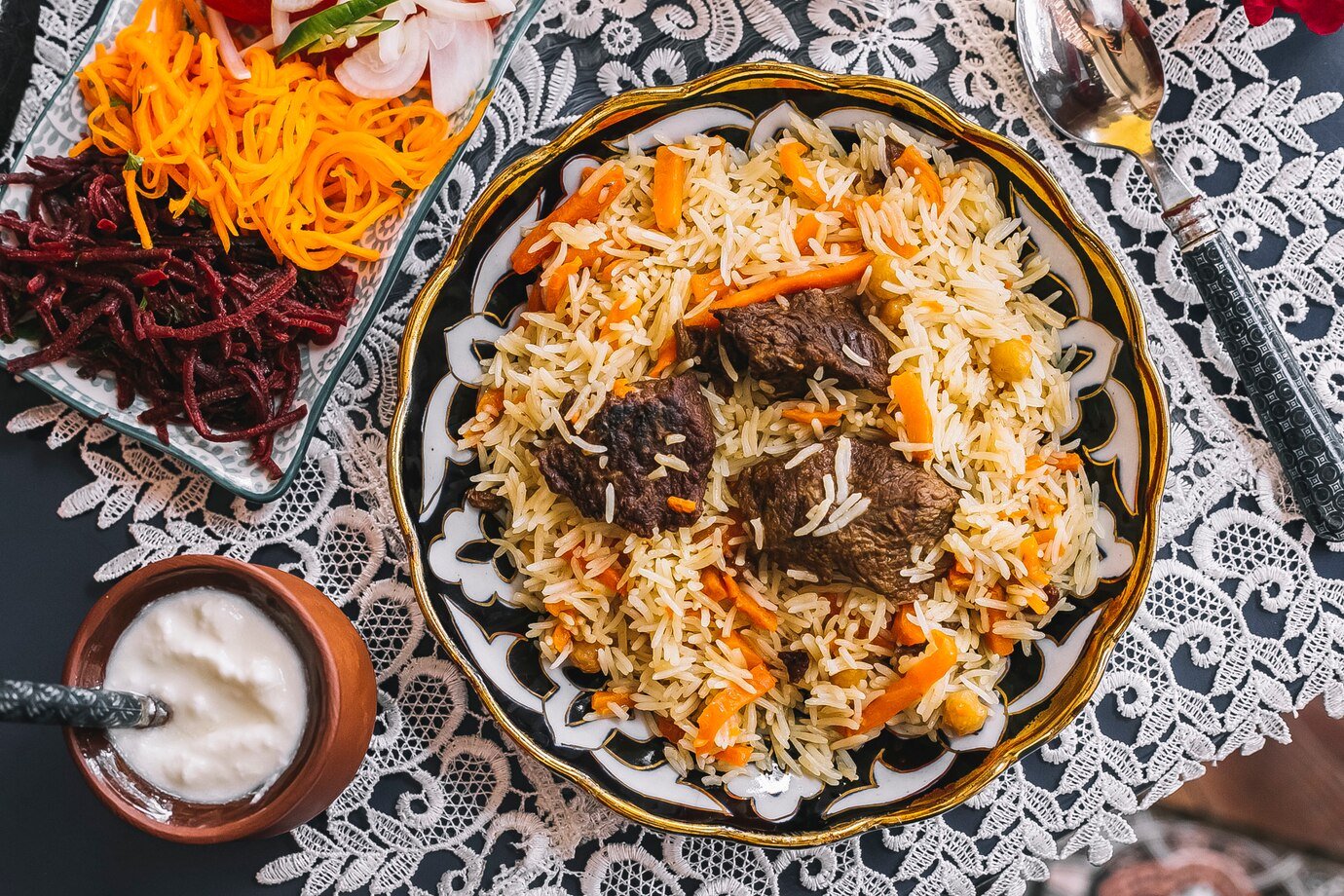
Originating from Lucknow, North India, this biryani is known for its subtle flavors, with the meat and rice cooked separately and then layered.
Lucknowi Biryani, also known as Awadhi Biryani, is a fragrant and delicately flavored dish hailing from the city of Lucknow in Uttar Pradesh, India. This biryani is a hallmark of Awadhi cuisine, known for its sophisticated cooking techniques and emphasis on aromatic and subtle flavors. Unlike other varieties of biryani, Awadhi Biryani is characterized by its cooking method, where the meat and rice are partially cooked separately before being layered and cooked together in a process known as Dum Pukht (slow oven). The result is a less spicy but highly aromatic and flavorful biryani.
| Ingredients: | ||
|---|---|---|
| For the Meat Marinade: | For the Rice: | For Cooking: |
| 1 kg mutton or chicken (cut into pieces) | 2 1/2 cups Basmati rice | 1 cup ghee (clarified butter) |
| 1 cup yogurt (whisked) | 10 cups water | 1 large onion, thinly sliced |
| 1 tablespoon ginger-garlic paste | 12 cloves | 1 teaspoon caraway seeds (shahi jeera) |
| 1 teaspoon turmeric powder | 12 green cardamoms | 12 green cardamoms |
| 2 teaspoons garam masala | 1 bay leaf | 1 black cardamom |
| 1/2 teaspoon saffron strands (soaked in 2 tablespoons warm milk) | 1 cinnamon stick | 2 cloves |
| Salt to taste | Salt to taste | 1 inch piece cinnamon |
| Juice of 1 lemon | Saffron soaked in 1/4 cup warm milk | |
| 2 tablespoons ghee (clarified butter) | Additional mint and cilantro for garnishing | |
| 1/2 cup fried onions | Dough (for sealing the cooking pot) | |
| 1/2 cup fresh mint leaves (chopped) | ||
| 1/2 cup fresh cilantro (coriander leaves, chopped) |
Instructions:
- Marinate the Meat:
In a large bowl, combine the yogurt, ginger-garlic paste, turmeric, garam masala, saffron milk, salt, lemon juice, ghee, fried onions, mint, and cilantro. Add the meat and mix well until evenly coated. Marinate for at least 4 hours, preferably overnight in the refrigerator.
- Prepare the Rice:
Rinse the Basmati rice until the water runs clear. Soak the rice for 30 minutes, then drain.
Bring water to a boil in a large pot. Add cloves, green cardamoms, bay leaf, cinnamon, and salt. Add the rice and cook until it’s 70% done. Drain and set aside.
- Cook the Meat:
In a heavy bottomed pot, heat ghee over medium heat. Add caraway seeds, green cardamoms, black cardamom, cloves, and cinnamon. Sauté for a minute.
Add the marinated meat and spread it evenly. Cook on high heat for 23 minutes, and then reduce the heat to low. Cook until the meat is tender (the time will vary depending on whether you’re using chicken or mutton).
- Layer the Biryani:
Once the meat is tender, layer the partially cooked rice over the meat. Sprinkle the saffron infused milk, and some more ghee. Garnish with additional fried onions, mint, and cilantro.
- Seal and Cook:
Seal the pot with a tight fitting lid. You can seal the edges with dough to ensure that steam does not escape.
Cook on a very low heat for about 30 to 40 minutes to allow the biryani to cook in its own steam (Dum Pukht).
- Serve:
Let the biryani rest for about 10 minutes after cooking. Gently fluff and mix the layers before serving.
Serve hot with raita, sliced onions, and lemon wedges on the side.
Enjoy the rich and nuanced flavors of Lucknowi (Awadhi) Biryani, a true testament to the sophisticated and aromatic world of Awadhi cuisine.
3. Kolkata (Calcutta) Biryani:
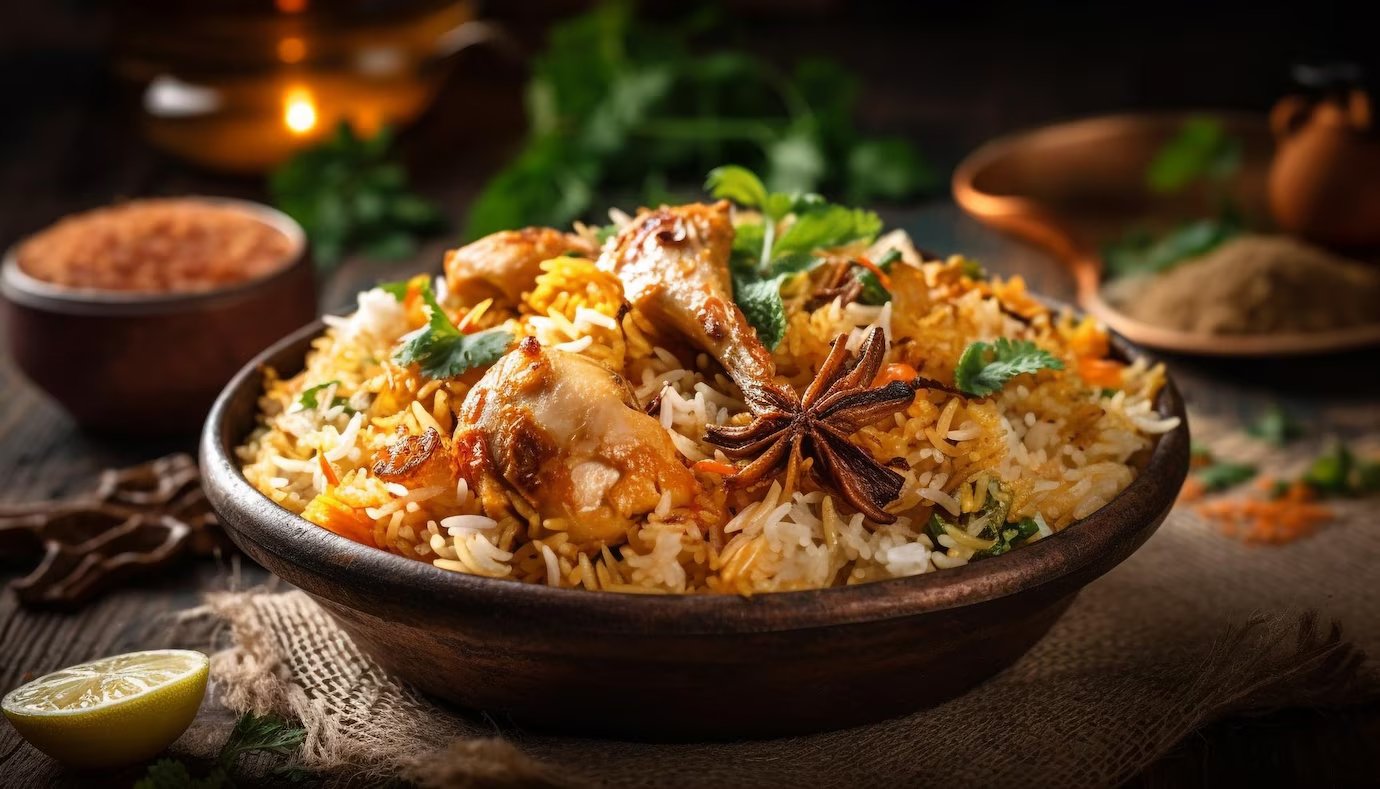
Unique for its inclusion of potatoes and eggs, the Kolkata biryani is known for its light, aromatic flavor, a legacy of the Nawab of Bengal.
Kolkata Biryani holds a unique place in the rich tapestry of biryani varieties across the Indian subcontinent. Originating from Kolkata (formerly Calcutta), this biryani is a testament to the cultural syncretism of the region, embodying a blend of Mughlai and Awadhi influences with local tastes. Distinct for its use of light spices, including the addition of potatoes and sometimes boiled eggs, the Kolkata Biryani is known for its subtlety in flavors compared to its more robust counterparts. It is a delightful mix of fragrant rice, tender meat, and the signature potatoes, all cooked together to perfection.
| Ingredients: | ||
|---|---|---|
| For the Marinade: | For the Rice: | Additional Ingredients: |
| 1 kg chicken or mutton, cut into pieces | 2 1/2 cups Basmati rice | 8 to 10 medium potatoes, peeled and halved |
| 1 cup yogurt | Water for boiling | 4 tablespoons ghee (clarified butter) |
| 2 tablespoons ginger-garlic paste | 15 green cardamoms | 1 large onion, thinly sliced |
| 1 teaspoon turmeric powder | 13 cloves | 1/2 teaspoon saffron strands, soaked in 1/4 cup warm milk |
| 2 teaspoons red chili powder (adjust to taste) | 1 bay leaf | 12 green chilies, slit |
| 1 tablespoon Kolkata biryani masala (or garam masala as a substitute) | 1 cinnamon stick | 1 teaspoon rose water (optional) |
| Salt to taste | Salt to taste | 1 teaspoon kewra water (optional) |
| 2 tablespoons mustard oil (for an authentic touch) | Fresh mint leaves (for garnish) |
Instructions:
- Marinate the Meat:
In a large bowl, mix the yogurt, ginger-garlic paste, turmeric powder, red chili powder, biryani masala, salt, and mustard oil. Add the chicken or mutton pieces and ensure they are well coated with the marinade. Let it marinate for at least 34 hours, preferably overnight in the refrigerator.
- Prepare the Potatoes:
Boil the potato halves until they are half cooked. Lightly fry them in 2 tablespoons of ghee until golden brown. Set aside.
- Cook the Rice:
Rinse the Basmati rice under cold running water until the water runs clear. Soak for 30 minutes, then drain.
In a large pot, bring water to a boil. Add cardamoms, cloves, bay leaf, cinnamon, and salt. Add the rice and cook until it’s about 70% done. Drain and set aside.
- Fry the Onions:
In a pan, heat the remaining ghee and fry the sliced onions until they are golden brown and crispy. Set aside on a paper towel to drain the excess ghee.
- Layering the Biryani:
In a heavy bottomed pot, add a layer of marinated chicken or mutton at the bottom. Then, add a layer of half cooked rice over it.
Sprinkle half of the saffron milk, half of the fried onions, the green chilies, and place the fried potatoes on top. Repeat the layers until all ingredients are used, finishing with a layer of rice on top.
Drizzle the remaining saffron milk, rose water, and kewra water over the final layer. Garnish with the remaining fried onions and mint leaves.
- Cook the Biryani:
Cover the pot with a tight fitting lid. You can also seal the edges with dough to trap the steam.
Cook on a low flame for about 45 minutes to an hour, allowing the biryani to cook in its own steam (Dum).
- Serve:
Let the biryani sit for about 10 minutes after cooking. Gently fluff and mix the layers before serving.
Serve hot with raita and salad on the side.
The Kolkata Biryani, with its distinctive flavors and the heartiness of potatoes, offers a unique biryani experience that is both subtle and satisfying.
4. Malabar Biryani:
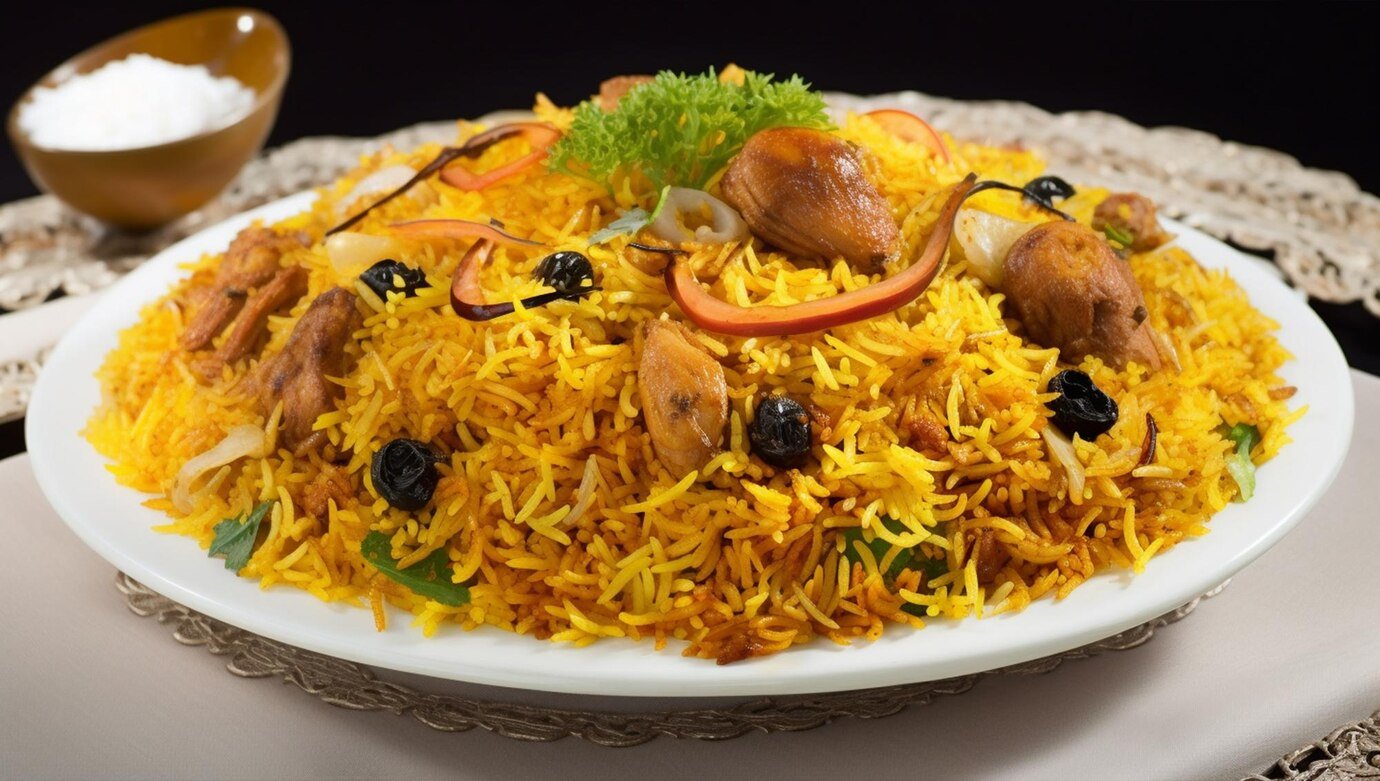
From the coastal regions of Kerala, this biryani stands out for its use of local spices, ghee, and the choice of rice, often using a type of short grained rice known as Jeerakasala.
Malabar Biryani, also known as Kerala Biryani, originates from the Malabar coast of Kerala and stands out for its unique flavors and preparation methods. It is particularly famous in areas like Kozhikode (Calicut), Malappuram, and Thalassery. Each of these places claims its own variant of Malabar Biryani, with slight differences in the ingredients and techniques, but all are characterized by the aromatic blend of spices, the use of jeerakasala or kaima rice instead of basmati, and the generous use of fried onions, cashews, and raisins. Here, we’ll focus on a general recipe that captures the essence of Malabar Biryani.
| Ingredients: | |||
|---|---|---|---|
| For the Chicken Marinade: | For the Rice: | For the Biryani Masala: | Additional Ingredients: |
| 1 kg chicken, cut into pieces | 2 1/2 cups jeerakasala or kaima rice (if unavailable, basmati can be used as a substitute) | 2 large onions, thinly sliced | 1/4 cup cashews |
| 1 cup thick yogurt | 4 cups water | 2 tomatoes, chopped | 1/4 cup raisins |
| 2 tablespoons ginger-garlic paste | 12 cloves | 1/2 cup mint leaves, chopped | 1/2 teaspoon saffron strands, soaked in 1/4 cup warm milk |
| 2 teaspoons chili powder | 2 cinnamon sticks | 1/2 cup cilantro (coriander leaves), chopped | 2 tablespoons rose water (optional) |
| 1/2 teaspoon turmeric powder | 15 green cardamoms | 12 green chilies, slit | Ghee, for frying |
| 1 teaspoon garam masala | 2 bay leaves | 1 tablespoon garam masala | |
| Salt, to taste | Salt, to taste | 1/2 cup fried onions | |
| Juice of 1 lemon | 1/4 cup ghee (clarified butter) |
Instructions:
- Marinate the Chicken:
Combine yogurt, ginger-garlic paste, chili powder, turmeric, garam masala, salt, and lemon juice in a bowl. Add the chicken pieces, ensuring they are well coated. Marinate for at least 2 hours, or overnight for best results.
- Cook the Rice:
Wash the jeerakasala or kaima rice until water runs clear. Soak for 30 minutes, then drain.
Boil water in a large pot with cloves, cinnamon, cardamoms, bay leaves, and salt. Add the rice and cook until it’s 70% done. Drain and set aside.
- Prepare the Biryani Masala:
In a large pan, heat ghee. Fry the cashews and raisins until golden, then set aside. In the same pan, add the sliced onions and sauté until golden brown.
Add the marinated chicken, tomatoes, green chilies, half of the mint and cilantro, and cook until the chicken is tender and the masala thickens.
- Layering the Biryani:
In a heavy bottomed pot, layer half of the cooked rice. Over it, spread the chicken masala, then sprinkle half of the fried onions, mint, cilantro, fried cashews, and raisins.
Add the remaining rice as the next layer. Sprinkle the rest of the fried onions, mint, cilantro, cashews, and raisins. Pour the saffron milk and rose water evenly over the top.
- Dum Cooking:
Cover the pot with a tight lid. Seal with dough if needed. Cook on low heat for about 20 to 25 minutes to allow the flavors to meld.
- Serve:
Let the biryani rest for about 10 minutes after cooking. Gently fluff and mix the layers before serving.
Serve hot with pickle, raita, or a Malabar style salad known as ‘salad’.
Malabar Biryani is a celebration of flavors, aromas, and textures, embodying the coastal culinary heritage of Kerala. Its distinctive taste comes from the regional spices, the choice of rice, and the layered cooking technique, making it a musttry for any biryani enthusiast.
5. Sindhi Biryani:
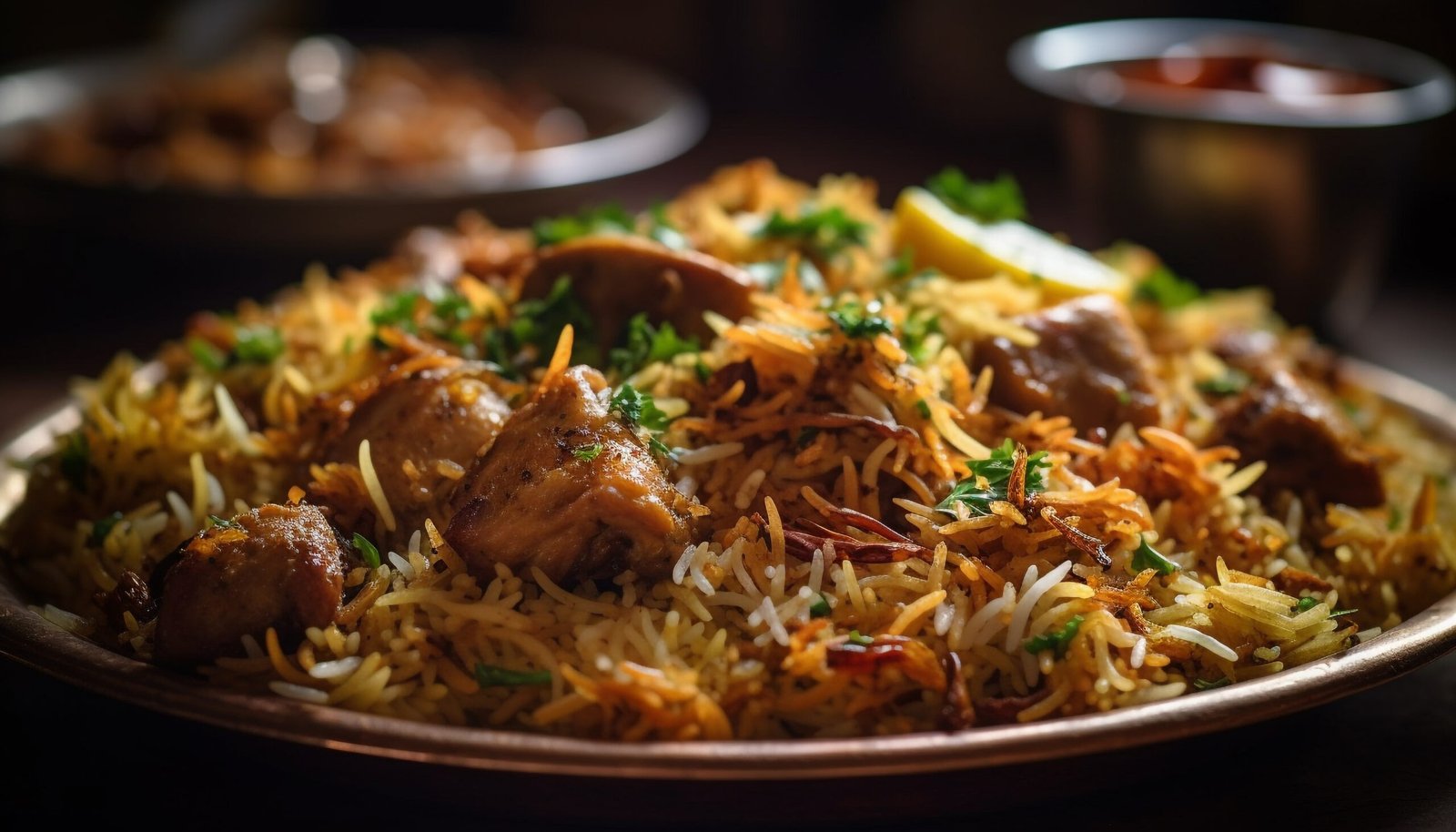
Popular in Pakistan, this version is spicy, tangy, and often uses yogurt in its marinade, along with generous amounts of chili and fried onions.
Sindhi Biryani is a beloved dish in Pakistani cuisine, renowned for its spicy taste, fragrant aroma, and richly seasoned rice and meat (usually chicken, mutton, or beef). It’s distinguished by the generous use of spicy and tangy ingredients, like tomatoes, yogurt, and fresh herbs, combined with a unique blend of Sindhi biryani masala. Here’s a recipe to bring the zest and flavor of Sindhi Biryani to your kitchen.
| Ingredients: | |
|---|---|
| For the Biryani Masala: | For the Biryani: |
| 2 tsp coriander seeds | 500g basmati rice |
| 1 tsp cumin seeds | 500g chicken, cut into pieces |
| 1/2 tsp fennel seeds | 4 big tbsp oil or ghee |
| 1/2 tsp mustard seeds | 2 large onions, thinly sliced |
| 10 dried red chilies | 2 tomatoes, chopped |
| 15 black peppercorns | 1 cup yogurt, whisked |
| 15 cloves | 8 green chilies, slit |
| 2 black cardamom pods | 1 tbsp gingergarlic paste |
| 15 green cardamom pods | 1/2 cup fresh cilantro (coriander leaves), chopped |
| 1 inch cinnamon stick | 1/2 cup fresh mint leaves, chopped |
| 1/2 tsp turmeric powder | Juice of 1 lemon |
| Grind all the above to make a fine powder. You can adjust the spices according to your taste preference. | Salt, to taste |
| Saffron strands soaked in 1/4 cup warm milk (optional) | |
| 10 boiled eggs (optional) |
Instructions:
- Prepare the Rice:
Wash the basmati rice under cold running water until the water runs clear. Soak the rice for at least 30 minutes.
Bring a large pot of water to boil, add salt, and cook the rice until it’s about 70% done. Drain and set aside.
- Cook the Chicken:
Heat oil or ghee in a large pot. Add the sliced onions and fry until golden brown. Remove half for garnishing later.
To the remaining onions, add ginger-garlic paste, and sauté for a minute.
Add the chicken pieces, prepared biryani masala, tomatoes, green chilies, half of the mint, and cilantro. Cook until the tomatoes are soft.
Add the whisked yogurt, lemon juice, and salt. Cook until the chicken is tender and the oil starts to separate from the gravy.
- Layer the Biryani:
In a separate heavy bottomed pot, add a layer of cooked chicken mixture, then a layer of rice. Sprinkle some of the reserved fried onions, mint, and cilantro.
Repeat the layers, finishing with a layer of rice on top. Sprinkle the remaining fried onions, mint, cilantro, and saffron milk (if using) over the final layer.
- Dum Cooking:
Cover the pot with a tightfitting lid. You can seal the edges with dough to ensure no steam escapes.
Cook on a very low flame for about 25 to 30 minutes, allowing the biryani to cook in its own steam.
- Serving:
Gently mix the biryani before serving to ensure the layers of rice and chicken are evenly distributed.
Serve hot, garnished with boiled eggs (if using), and accompanied by raita and salad.
Sindhi Biryani, with its spicy flavor profile and comforting texture, is perfect for a festive occasion or a weekend family dinner. Enjoy the complex flavors and aromas that make this dish a standout in South Asian cuisine.
6. Vegetarian Biryani:
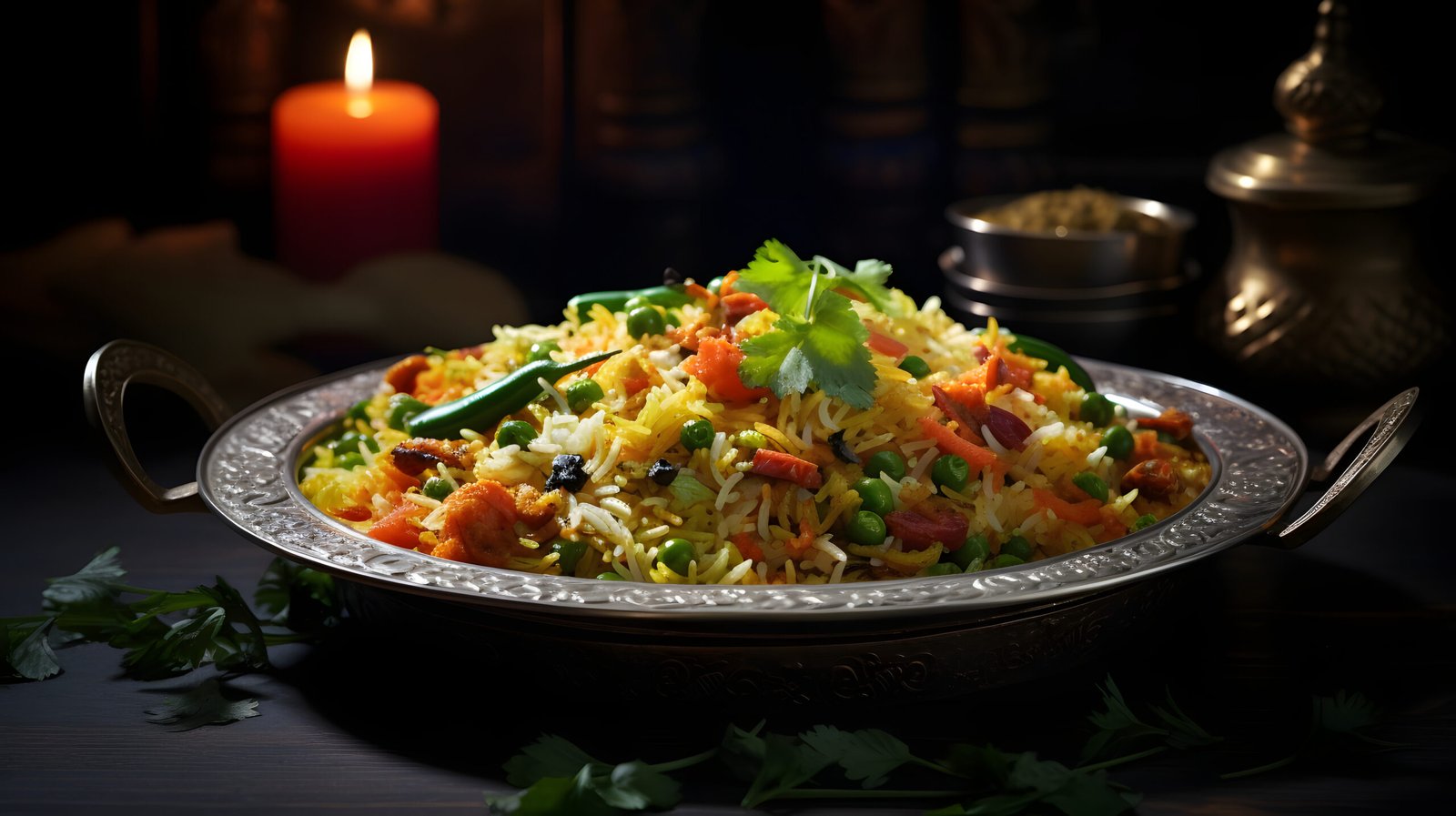
While traditionally biryani is associated with meat, vegetarian versions are equally popular, made with a variety of vegetables and sometimes paneer (Indian cottage cheese).
Vegetarian Biryani is a delightful and aromatic rice dish that’s packed with layers of vegetables, spices, and sometimes paneer (Indian cottage cheese), making it a satisfying meal for vegetarians and a pleasant surprise for meat eaters alike. Here’s how you can prepare this colorful and flavorful dish at home.
| Ingredients: | ||
|---|---|---|
| For the Rice: | For the Vegetables: | For the Marinade: |
| 2 cups Basmati rice | 1 large onion, thinly sliced | 1 cup yogurt |
| Water for soaking and boiling | 2 medium carrots, chopped | 1 tablespoon ginger-garlic paste |
| 15 cloves | 1 cup green peas (fresh or frozen) | 2 teaspoons biryani masala or garam masala |
| 10 green cardamoms | 1 large potato, cubed | 1/2 teaspoon turmeric powder |
| 1 bay leaf | 1 bell pepper, chopped | 1 teaspoon red chili powder (adjust to taste) |
| 1 small cinnamon stick | 1 cup cauliflower florets | 1/2 teaspoon cumin powder |
| Salt, to taste | 1 cup chopped green beans | Salt, to taste |
| 200g paneer (optional), cubed | Fresh cilantro (coriander leaves), chopped | |
| 2 tablespoons oil or ghee | Fresh mint leaves, chopped | |
| 1 teaspoon cumin seeds | Saffron strands soaked in 1/4 cup warm milk (optional) | |
| 8 to 10 bay leaves |
Instructions:
- Prepare the Rice:
Rinse the Basmati rice until the water runs clear, then soak it in water for about 30 minutes. Drain.
Bring a large pot of water to a boil. Add cloves, cardamoms, bay leaf, cinnamon, and salt. Add the soaked rice and cook until it’s about 70% done. Drain and set aside.
- Marinate the Vegetables:
In a large bowl, combine the yogurt, ginger-garlic paste, biryani masala, turmeric, red chili, cumin powder, and salt. Add the chopped vegetables (and paneer, if using) to the marinade. Mix well to ensure the vegetables are coated. Let it marinate for at least 30 minutes.
- Cook the Vegetables:
Heat oil or ghee in a large pan. Add cumin seeds and bay leaves, letting them sizzle.
Add the marinated vegetables (and paneer, if using) to the pan. Cook over medium heat until the vegetables are just tender, about 10 to 15 minutes. You don’t want them to become mushy since they will cook further with the rice.
- Layer the Biryani:
In a heavy bottomed pot, layer half of the cooked vegetables at the bottom. Spread half of the rice over the vegetables. Sprinkle some chopped cilantro and mint, and drizzle some saffron milk over the rice.
Repeat the layers with the remaining vegetables and rice. Finish with a layer of rice on top, garnished with more cilantro, mint, and saffron milk.
- Cook the Biryani:
Cover the pot with a tight fitting lid. You can also seal the pot with dough to trap the steam.
Cook on a very low flame for about 20 to 25 minutes, allowing the biryani to steam (Dum cooking).
- Serve:
Let the biryani rest for a few minutes after cooking, then gently mix the layers.
Serve hot, accompanied by raita, pickle, and salad for a complete meal.
This Vegetarian Biryani brings out the best in seasonal vegetables, turning them into a feast for the senses with its rich flavors and enticing aroma. Enjoy!
7. Prawn Biyani:
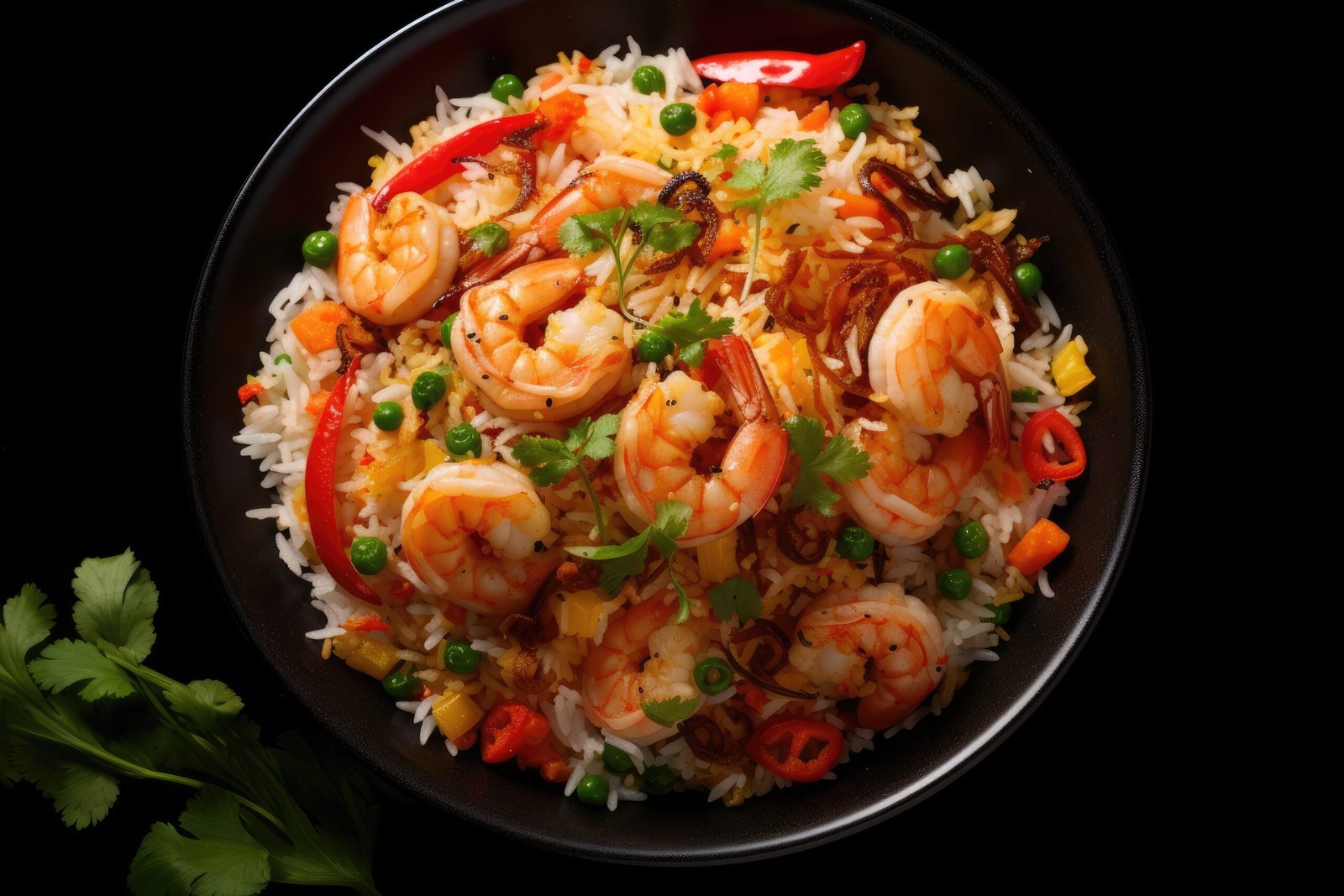
Prawn Biryani, with its rich flavors and succulent prawns nestled in fragrant rice, is a delightful seafood variation of the traditional biryani. This recipe balances the delicate taste of prawns with the robust spices typical of biryani, creating a dish that’s both aromatic and flavorful.
| Ingredients: | ||
|---|---|---|
| For Marinating Prawns: | For the Biryani Rice: | For the Biryani Masala: |
| 500g prawns, cleaned and deveined | 2 cups Basmati rice | 2 tablespoons oil or ghee |
| 1 teaspoon turmeric powder | Water for soaking and boiling | 1 large onion, thinly sliced |
| 1 teaspoon red chili powder | 12 cloves | 1 tablespoon ginger-garlic paste |
| 1/2 teaspoon salt | 10 green cardamoms | 2 medium tomatoes, finely chopped |
| 1 tablespoon lemon juice | 1 bay leaf | 1/2 cup yogurt, whisked |
| 1 small cinnamon stick | 8 green chilies, slit (adjust to taste) | |
| Salt, to taste | 1 teaspoon garam masala | |
| 1 teaspoon coriander powder | ||
| 1/2 teaspoon cumin powder | ||
| 1/2 cup mint leaves, chopped | ||
| 1/2 cup cilantro (coriander leaves), chopped | ||
| Saffron strands soaked in 1/4 cup warm milk (optional) | ||
| Salt, to taste |
Instructions:
- Marinate the Prawns:
In a bowl, combine the prawns with turmeric powder, red chili powder, salt, and lemon juice. Mix well and let it marinate for about 15 to 20 minutes.
- Prepare the Rice:
Wash the Basmati rice under cold running water until the water runs clear. Soak for about 30 minutes, then drain.
Bring a large pot of water to a boil. Add the cloves, cardamoms, bay leaf, cinnamon, and salt. Add the soaked rice and cook until it’s about 70% done. Drain and set aside.
- Cook the Prawns:
Heat oil or ghee in a pan over medium heat. Add the sliced onions and fry until they are golden brown. Remove half for garnishing later.
Add ginger-garlic paste to the same pan and sauté for a minute until fragrant.
Add the marinated prawns and cook for about 23 minutes until they start changing color. Be careful not to overcook the prawns at this stage.
Add the chopped tomatoes, yogurt, green chilies, garam masala, coriander powder, and cumin powder. Cook until the tomatoes are soft and the masala is well blended, about 57 minutes. Adjust the seasoning as needed.
- Layer the Biryani:
In a heavy bottomed pot, spread half of the prawn masala as the first layer. Top it with half of the cooked rice.
Sprinkle half of the mint, cilantro, and soaked saffron milk over the rice. Repeat the layers, finishing with a layer of rice on top. Sprinkle the remaining mint, cilantro, and saffron milk over the final layer. Scatter the fried onions reserved earlier.
- Cook the Biryani (Dum):
Cover the pot with a tight fitting lid. You can seal the edges with dough to ensure no steam escapes.
Cook on a very low flame for about 20 minutes, allowing the biryani to cook in its own steam and the flavors to meld together.
- Serve:
Allow the biryani to sit for about 10 minutes after cooking. Gently fluff up the rice before serving.
Serve hot with raita or your choice of side dish.
Enjoy the exquisite flavors of Prawn Biryani, a dish that perfectly marries the succulence of prawns with the rich heritage of biryani spices.
8. Fish Biryani:

Fish Biryani is a delectable seafood variation of the traditional biryani, combining the rich flavors of spices and the delicate taste of fish. It’s a treat for seafood lovers, offering a lighter but equally aromatic alternative to its meat counterparts. Here’s how to prepare Fish Biryani at home.
| Ingredients: | ||
|---|---|---|
| For Marinating Fish: | For the Rice: | For the Biryani Masala: |
| 500g fish fillets (such as cod, salmon, or any firm white fish), cut into pieces | 2 cups Basmati rice | 2 tablespoons oil or ghee |
| 1 teaspoon turmeric powder | Water for soaking and boiling | 1 large onion, thinly sliced |
| 1 teaspoon red chili powder | 8 to 10 cloves | 1 tablespoon ginger-garlic paste |
| 1 teaspoon ginger-garlic paste | 10 green cardamoms | 2 medium tomatoes, finely chopped |
| 1 tablespoon lemon juice | 1 bay leaf | 1/2 cup yogurt, whisked |
| Salt, to taste | 1 small cinnamon stick | 8 green chilies, slit (adjust to taste) |
| Salt, to taste | 1 teaspoon garam masala | |
| 1 teaspoon coriander powder | ||
| 1/2 teaspoon turmeric powder | ||
| 1/2 teaspoon red chili powder (adjust to taste) | ||
| 1/2 cup mint leaves, chopped | ||
| 1/2 cup cilantro (coriander leaves), chopped | ||
| Saffron strands soaked in 1/4 cup warm milk (optional) | ||
| Salt, to taste |
Instructions:
- Marinate the Fish:
In a bowl, mix the turmeric powder, red chili powder, ginger-garlic paste, lemon juice, and salt. Coat the fish pieces in this marinade and let them sit for about 30 minutes.
- Prepare the Rice:
Rinse the Basmati rice under cold running water until the water runs clear. Soak for about 30 minutes, then drain.
Bring a large pot of water to a boil. Add the cloves, cardamoms, bay leaf, cinnamon, and salt. Add the soaked rice and cook until it’s about 70% done. Drain and set aside.
- Cook the Fish:
Heat a large pan with oil or ghee over medium heat. Gently place the marinated fish pieces in the pan. Cook for 23 minutes on each side, just until the fish is half cooked. Remove and set aside.
- Prepare the Masala:
In the same pan, add more oil if needed. Fry the sliced onions until golden brown. Set aside some onions for garnishing later.
Add ginger-garlic paste to the pan and sauté for a minute. Then add the chopped tomatoes, yogurt, green chilies, garam masala, coriander powder, turmeric powder, and red chili powder. Cook until the oil starts to separate from the masala.
Add half of the mint and cilantro to the masala and mix well.
- Layer the Biryani:
In a heavy bottomed pot, spread a layer of the prepared masala. Place the half cooked fish pieces over it. Cover the fish with half of the cooked rice. Sprinkle some of the fried onions, remaining mint, and cilantro. Repeat the layers, ending with a layer of rice on top.
Drizzle the saffron infused milk over the final layer of rice for added flavor and color.
- Dum Cooking:
Cover the pot with a tight fitting lid. You can seal the edges with dough to ensure no steam escapes.
Cook on a very low flame for about 20 minutes, allowing the biryani to cook in its own steam and the flavors to meld together.
- Serving:
Let the biryani rest for a few minutes after cooking. Gently fluff up the rice before serving.
Serve hot, garnished with the reserved fried onions, and accompanied by raita or your choice of side.
Fish Biryani brings a unique and delicious twist to the biryani family, perfect for a special occasion or when you’re craving something different. Enjoy the delightful combination of tender fish and flavorful rice!
9. Lamb Biryani:
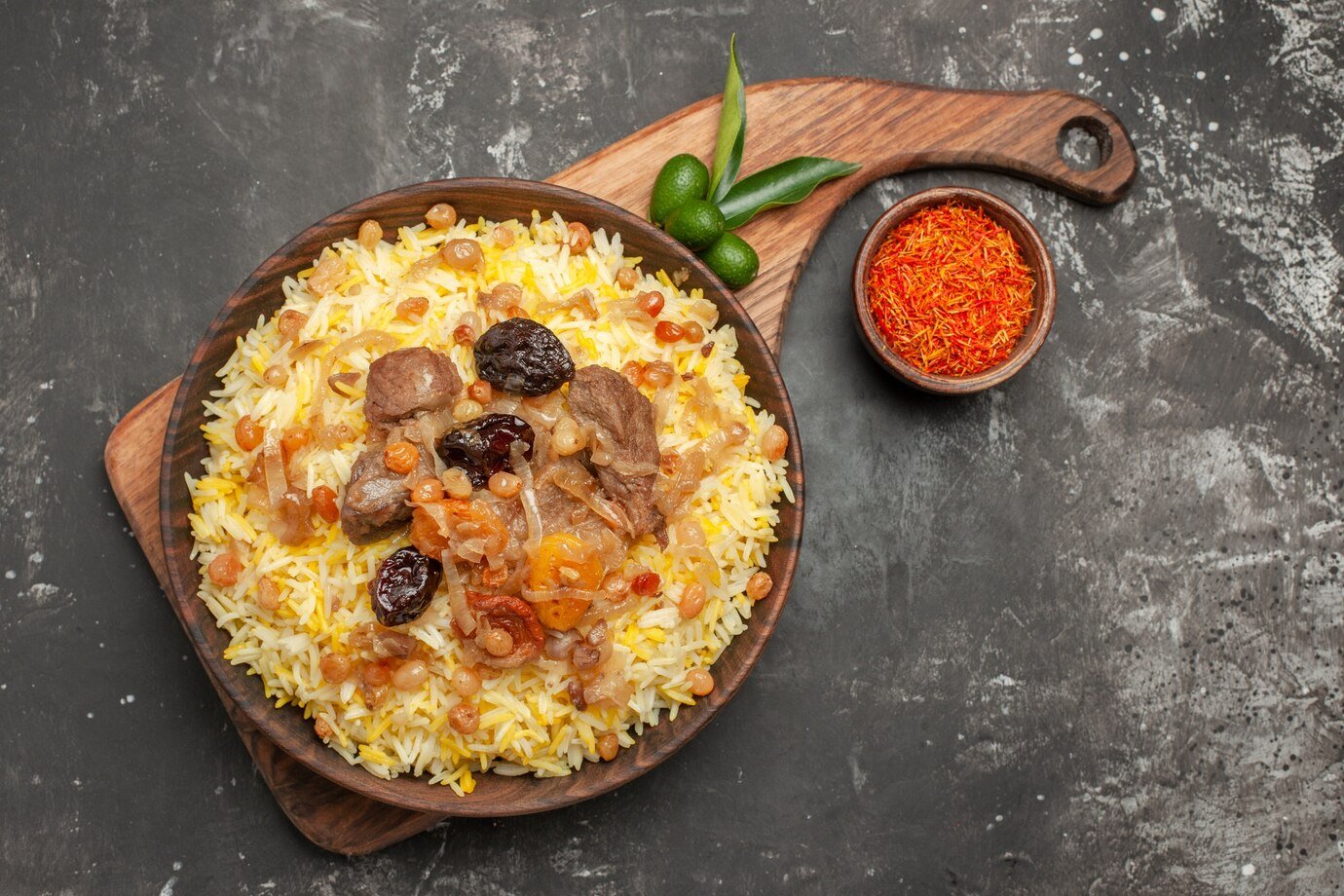
is a majestic dish that brings the rich flavors of tender lamb meat together with fragrant Basmati rice, aromatic spices, and herbs. It’s a celebration dish often served during festivals, special occasions, or a luxurious weekend meal. Here’s a detailed recipe to make Lamb Biryani at home.
| Ingredients: | ||
|---|---|---|
| For Marinating the Lamb: | For the Rice: | For the Biryani: |
| 1 kg lamb, cut into medium sized pieces | 3 cups Basmati rice | 4 tablespoons oil or ghee |
| 1 cup yogurt | Water for soaking and boiling | 2 large onions, thinly sliced |
| 2 tablespoons ginger-garlic paste | 15 cloves | 2 tomatoes, finely chopped |
| 2 teaspoons red chili powder | 10 green cardamoms | 1/2 cup fresh mint leaves, chopped |
| 1 teaspoon turmeric powder | 2 bay leaves | 1/2 cup fresh cilantro (coriander leaves), chopped |
| 2 teaspoons garam masala | 1 cinnamon stick | 8 green chilies, slit |
| Salt, to taste | Salt, to taste | Saffron strands soaked in 1/4 cup warm milk |
| 1 teaspoon rose water (optional) | ||
| 1 teaspoon kewra water (optional) | ||
| Additional salt, to taste | ||
| Additional garam masala, 1 teaspoon |
Instructions:
- Marinate the Lamb:
Mix the lamb pieces with yogurt, ginger-garlic paste, red chili powder, turmeric powder, garam masala, and salt in a large bowl. Ensure each piece is well coated with the marinade. Cover and refrigerate for at least 2 hours, preferably overnight.
- Cook the Rice:
Wash the Basmati rice under cold water until the water runs clear. Soak it for 30 minutes, then drain.
Bring a large pot of water to a boil. Add cloves, cardamoms, bay leaves, cinnamon stick, and salt. Add the soaked rice and cook until it’s about 70% done. Drain and set aside.
- Brown the Onions:
In a large, heavy bottomed pot or a Dutch oven, heat oil or ghee over medium heat. Add the sliced onions and fry until golden brown and crispy. Remove half for garnishing later and set aside.
- Cook the Lamb:
In the same pot, add the marinated lamb over medium high heat. Cook until the meat is browned.
Add the chopped tomatoes, half of the mint, and cilantro leaves, and green chilies. Cook until the tomatoes break down and the lamb is nearly tender, about 1.5 to 2 hours. Add water as necessary to prevent the mixture from drying out, but ensure it has a thick gravy consistency by the end.
- Layer the Biryani:
Preheat your oven to 180°C (350°F) if you choose to bake the biryani for the final step.
Over the lamb and gravy, sprinkle half of the remaining mint and cilantro. Layer half of the rice over this. Repeat with the remaining mint, cilantro, and rice. Sprinkle the soaked saffron milk, rose water, and kewra water over the top layer. Finally, add the fried onions you had set aside.
- Final Cooking (Dum):
If cooking on the stove, cover the pot with a tight lid and seal with dough if necessary. Cook on a very low heat for about 30 minutes.
If baking, cover the pot with aluminium foil and a lid, and bake in the preheated oven for about 30 to 40 minutes.
- Serve:
Let the biryani rest for about 10 minutes after cooking. Gently mix the layers before serving.
Serve hot with raita, sliced cucumbers, and boiled eggs if desired.
Lamb Biryani is a labor of love that rewards you with its deep, complex flavors and tender meat. Enjoy the process and the delicious outcome!
Conclusion
Biryani’s history is a testament to the rich cultural intermingling that characterizes the Indian subcontinent. From royal kitchens to street vendors, biryani continues to be celebrated and loved by millions, each version telling its own story of origin, tradition, and local flavor. Whether it’s the royal Hyderabadi biryani, the aromatic Lucknowi version, or the spicy Sindhi biryani, each type offers a unique taste experience, making biryani not just a dish, but a celebration of diversity and culinary excellence.
